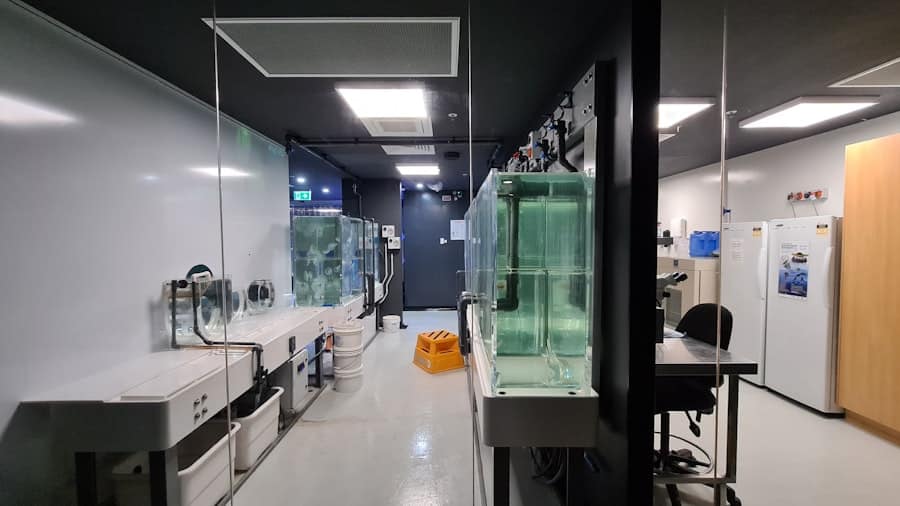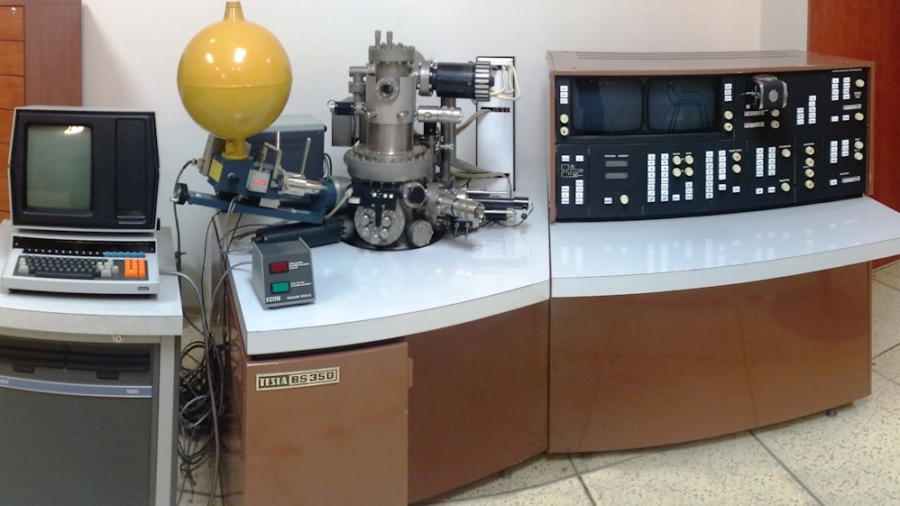Quantum simulation is an emerging field that leverages the principles of quantum mechanics to model complex systems that are otherwise intractable using classical computational methods. At its core, quantum simulation seeks to replicate the behavior of quantum systems, allowing researchers to explore phenomena that are fundamentally quantum in nature. This capability is particularly significant in fields such as chemistry and materials science, where the interactions between particles can lead to emergent properties that are difficult to predict.
The advent of quantum computers has opened new avenues for simulating these systems with unprecedented accuracy and efficiency. The importance of quantum simulation extends beyond theoretical exploration; it has practical implications in various industries, particularly in drug discovery. Traditional methods of drug development often rely on empirical approaches and classical simulations, which can be time-consuming and resource-intensive.
Quantum simulation offers a paradigm shift by enabling scientists to model molecular interactions at a level of detail that was previously unattainable. This capability not only accelerates the drug discovery process but also enhances the precision with which new compounds can be designed and tested.
Key Takeaways
- Quantum simulation is a powerful tool that uses quantum computers to model and simulate complex systems, such as molecules and materials, with unprecedented accuracy and efficiency.
- Quantum simulation has the potential to revolutionize drug discovery by enabling researchers to accurately predict the behavior of molecules and design new drugs with higher success rates and lower costs.
- The advantages of quantum simulation in drug discovery include its ability to accurately model molecular interactions, predict drug efficacy and toxicity, and accelerate the drug development process.
- Quantum simulation techniques used in drug discovery include variational quantum eigensolver (VQE), quantum approximate optimization algorithm (QAOA), and quantum Monte Carlo (QMC) methods, among others.
- Case studies have demonstrated the successful application of quantum simulation in drug discovery, such as the design of new antibiotics and the optimization of drug candidates for specific targets.
- Challenges and limitations of quantum simulation in drug discovery include the current limitations of quantum hardware, the complexity of simulating large molecules, and the need for specialized expertise in quantum computing and chemistry.
- Future applications of quantum simulation in drug discovery include the development of personalized medicine, the design of novel drug delivery systems, and the exploration of new therapeutic targets.
- In conclusion, quantum simulation has the potential to significantly impact drug discovery by accelerating the development of new drugs, reducing costs, and improving patient outcomes.
The Role of Quantum Simulation in Drug Discovery
In the realm of drug discovery, quantum simulation plays a pivotal role by providing insights into molecular interactions and biochemical processes at the quantum level. The ability to simulate the electronic structure of molecules allows researchers to predict how potential drug candidates will interact with biological targets, such as proteins or nucleic acids. This predictive power is crucial for identifying promising compounds early in the development process, thereby reducing the time and cost associated with bringing new drugs to market.
For instance, understanding the dynamics of protein folding or the mechanisms of enzyme catalysis requires a detailed knowledge of quantum effects that influence these processes. By employing quantum simulation techniques, researchers can gain a deeper understanding of these phenomena, leading to more effective drug design strategies.
This capability is particularly valuable in addressing diseases that have proven resistant to conventional treatment approaches, as it allows for the identification of novel therapeutic targets and strategies.
Advantages of Quantum Simulation in Drug Discovery

One of the most significant advantages of quantum simulation in drug discovery is its ability to model molecular systems with high fidelity. Classical simulations often rely on approximations that can lead to inaccuracies, particularly when dealing with complex interactions involving many-body systems. Quantum simulation, on the other hand, can account for the full range of quantum effects, providing a more accurate representation of molecular behavior.
This precision is essential for understanding how drugs interact with their targets and for optimizing their efficacy. Additionally, quantum simulation can dramatically reduce the computational resources required for drug discovery. Traditional methods often involve extensive trial-and-error approaches, necessitating large amounts of computational power and time.
Quantum computers, however, can process vast amounts of information simultaneously due to their inherent parallelism. This capability allows researchers to explore a broader chemical space more efficiently, identifying potential drug candidates faster than ever before. As a result, pharmaceutical companies can streamline their research and development processes, ultimately leading to quicker delivery of new therapies to patients.
Quantum Simulation Techniques used in Drug Discovery
Several quantum simulation techniques are currently being explored and utilized in drug discovery, each with its unique strengths and applications. One prominent method is Variational Quantum Eigensolver (VQE), which is particularly suited for finding the ground state energy of molecular systems. VQE employs a hybrid approach that combines classical optimization techniques with quantum computations, making it feasible even on near-term quantum devices.
This method has been successfully applied to small molecules, providing insights into their electronic structures and potential reactivity. Another important technique is Quantum Phase Estimation (QPE), which allows for the precise determination of energy levels in quantum systems. QPE can be used to study excited states of molecules, which are critical for understanding photochemical reactions and other processes that involve energy transfer.
By accurately calculating these energy levels, researchers can gain insights into how drugs might behave under different conditions, such as varying temperatures or pH levels. Furthermore, Quantum Monte Carlo (QMC) methods are being adapted for use in drug discovery. QMC techniques leverage stochastic sampling to estimate properties of quantum systems, making them particularly useful for studying large molecules or complex interactions that are challenging for other methods.
These techniques can provide valuable information about molecular dynamics and thermodynamics, aiding in the design of more effective drug candidates.
Case Studies of Successful Drug Discovery using Quantum Simulation
Several case studies illustrate the transformative potential of quantum simulation in drug discovery. One notable example involves the use of VQE to study the binding affinity of small molecules to protein targets. Researchers at a leading pharmaceutical company employed this technique to evaluate potential inhibitors for a specific enzyme implicated in cancer progression.
By accurately modeling the interactions between the enzyme and various small molecules, they were able to identify several promising candidates that exhibited high binding affinities. This approach not only accelerated the identification process but also provided insights into the molecular mechanisms underlying the enzyme’s activity. Another compelling case study comes from a collaboration between academic institutions and industry partners focused on antibiotic discovery.
The team utilized quantum simulation techniques to investigate the interactions between bacterial proteins and potential antibiotic compounds. By simulating these interactions at a quantum level, they were able to identify novel compounds that demonstrated significant antibacterial activity against resistant strains of bacteria. This work highlights how quantum simulation can address pressing public health challenges by facilitating the discovery of new antibiotics in an era where resistance is becoming increasingly prevalent.
Challenges and Limitations of Quantum Simulation in Drug Discovery

Despite its promise, quantum simulation in drug discovery faces several challenges and limitations that must be addressed for it to reach its full potential. One significant hurdle is the current state of quantum hardware. While advancements have been made in developing quantum computers, many existing devices are still limited in terms of qubit count and coherence times.
These limitations restrict the size and complexity of molecular systems that can be effectively simulated, making it difficult to apply quantum simulation techniques to larger drug candidates or intricate biological pathways. Additionally, there is a steep learning curve associated with quantum computing technologies and algorithms. Many researchers in drug discovery come from classical computational backgrounds and may lack the necessary expertise to effectively utilize quantum simulation tools.
Bridging this knowledge gap will require interdisciplinary collaboration between chemists, biologists, and computer scientists, as well as investment in education and training programs focused on quantum technologies.
Future Applications of Quantum Simulation in Drug Discovery
Looking ahead, the future applications of quantum simulation in drug discovery are vast and promising. As quantum hardware continues to improve, we can expect more sophisticated simulations that encompass larger molecular systems and more complex biological interactions. This advancement will enable researchers to tackle challenging problems such as protein-protein interactions or multi-target drug design, which are critical for developing therapies for multifactorial diseases like cancer or neurodegenerative disorders.
Moreover, as machine learning techniques become increasingly integrated with quantum computing, we may see hybrid approaches that combine classical data-driven methods with quantum simulations. Such integration could enhance predictive modeling capabilities, allowing researchers to identify potential drug candidates more efficiently by leveraging both empirical data and quantum mechanical insights. The potential for personalized medicine also stands out as a significant future application area for quantum simulation.
By simulating individual patients’ unique biological profiles at a molecular level, researchers could tailor drug therapies to optimize efficacy and minimize adverse effects. This approach could revolutionize treatment strategies across various medical fields, leading to more effective interventions based on individual patient characteristics.
The Impact of Quantum Simulation on Drug Discovery
The impact of quantum simulation on drug discovery is profound and multifaceted. By providing unprecedented insights into molecular interactions and enabling more accurate predictions of drug behavior, quantum simulation has the potential to transform how new therapies are developed. As researchers continue to explore this exciting frontier, we can anticipate significant advancements that will not only accelerate drug discovery timelines but also enhance the precision with which new treatments are designed.
As we stand on the cusp of a new era in pharmaceutical research driven by quantum technologies, it is essential for stakeholders across academia and industry to collaborate closely. By fostering interdisciplinary partnerships and investing in education and infrastructure, we can harness the full potential of quantum simulation to address some of the most pressing health challenges facing society today.
Quantum simulation is revolutionizing the field of drug discovery by enabling researchers to model complex molecular interactions with unprecedented accuracy. This innovative approach allows scientists to predict how potential drug compounds will behave in biological systems, significantly speeding up the development process. For further insights into the impact of technology on various fields, you might find the article on trusted reviews of the latest technology particularly interesting, as it explores how advancements in technology are shaping industries, including pharmaceuticals.
FAQs
What is quantum simulation?
Quantum simulation is a computational method that uses quantum mechanics to simulate the behavior of complex systems that are difficult to study using classical computers.
How does quantum simulation support drug discovery?
Quantum simulation can be used to model the behavior of molecules and proteins at the quantum level, providing insights into their interactions and properties. This can help in the design and optimization of new drugs.
What are the advantages of using quantum simulation in drug discovery?
Quantum simulation allows for a more accurate and detailed understanding of molecular interactions, which can lead to the development of more effective and targeted drugs. It also has the potential to significantly speed up the drug discovery process.
Are there any limitations to using quantum simulation in drug discovery?
Quantum simulation requires significant computational resources and expertise, and the simulations can be complex and time-consuming. Additionally, the accuracy of the simulations can be affected by the approximations and limitations of the quantum algorithms and hardware.
What are some examples of quantum simulation being used in drug discovery?
Researchers have used quantum simulation to study the behavior of proteins involved in diseases such as Alzheimer’s and cancer, as well as to design new drug candidates for various conditions.

